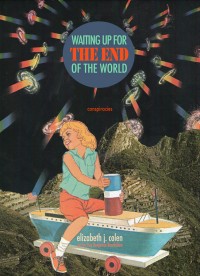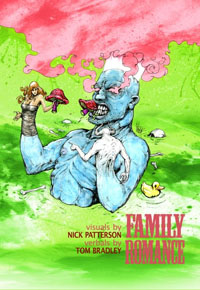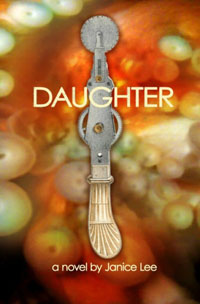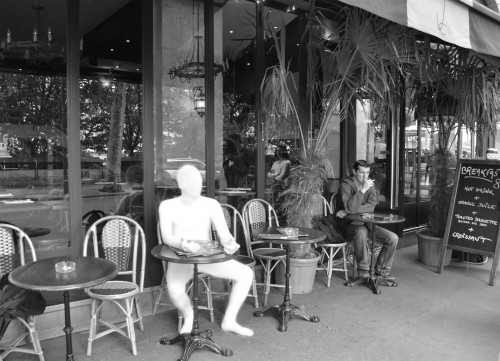Something Wrong With Her by Cris Mazza
 Something Wrong With Her
Something Wrong With Her
by Cris Mazza
Jaded Ibis Press, 2014
388 pages / $18 Buy from Jaded Ibis or Amazon
This amazing “real time” memoir by Cris Mazza deserves a love-letter, and also a review or maybe six, written at different points while the reviewer is reading. Some would be awed and respectful, some would be infuriated, or in tears. I was obsessed, and ended up forming intense bonds to the characters, the love story, and the way of telling. It’s such a complex book, it’s taken me months to try to write about it, and even now….
The basic format is that Mazza sets out to explore what she characterizes as her sexual dysfunction, which she intends to both confess and try to explain (to herself and to us), through an examination of her sexual and emotional history. But as she’s working on the book, she gets back in touch with a high school boyfriend, and the story she thinks she remembers starts to change. She begins to include the story of their current emailing, along with old journal entries, earlier draft versions of the same chapters, and excerpts from her previous published books, which have fictional versions of real events, remembered and re-created at different points in time.
A strange note: The book was supposed to come out in fall 2013, and a cover was released and some advance reviews came in, but due to problems with the publisher, it was finally published with a different cover in April 2014.
Most of the other writing on the book has addressed its feminism and sexual politics—Mazza is a well-respected writer of experimental literary fiction with 17 books to her name, known for graphic sexual content and a feminist bent. A previous novel was titled Is it Sexual Harassment Yet? She edited a collection of “chick lit” before that was a term that meant a pink-shoe. And yet in this book she confesses that she has or had vaginismus (a spasming condition that makes penis-in-vagina sex painful) and has never had an orgasm. She also admits to many un-modern-feminist thoughts, like considering herself to be frigid, and thinking her body is dirty.
Her honesty is brave, rare, and hopefully might be helpful to other women who suffer from the same problems. Mazza found talk-therapy to be useless and something called Pelvic Floor Therapy helpful in decreasing the pain during sex. It’s refreshing to hear a woman—especially an older woman—speak honestly about sex, especially when she’s admitting to the uncoolness of not liking it. As she points out, we usually hear from women who are having too much sex, and though this is presented as a flaw, “isn’t the unspoken aura that these women are—for the same reasons—exotic, worldly, exciting, charismatic, provocative…or just plain cool?”
July 28th, 2014 / 10:00 am
Yuriy Tarnawsky visits Chicago
This Friday and Saturday, Yuriy Tarnawsky will be reading in Chicago to celebrate the completion of his recent trilogy, The Placebo Effect.
On Friday, he will be reading at Quimby’s Bookstore (1854 W. North Ave.) with Eckhard Gerdes.
On Saturday, he will be reading at 567 Studio & Gallery (1800 N. Milwaukee Ave.) with Eckhard, Jane L. Carman, and myself.
Both readings start at 7pm, and are free and open to the public. A reception will follow the Saturday reading.
Here’s a recent interview with Yuriy regarding The Placebo Effect Trilogy, conducted by Tantra Bensko. And here’s an older interview that I conducted with Yuriy, about his life and work in general.
Since the 1950s, Yuriy Tarnawsky has published more than twenty books of fiction, poetry, drama, and criticism in English and Ukrainian. His most recent work has appeared via FC2, Jaded Ibis Press, and JEF Books. His Three Blondes and Death (FC2, 1993) remains, IMHO, one of the best English-language novels of the past thirty years—indeed, I think it the best book that FC2 has published. (You can read some of it here.)
Hope to see you there!
A Review of Davis Schneiderman’s [SIC]
 [SIC]
[SIC]
by Davis Schneiderman
Jaded Ibis Press, October 2013
154 pages / $16 Buy from Jaded Ibis Press or Amazon
As an undergraduate, Professor Barrick (my physics instructor) taught me that white light is all of the colors combined; in painting, white is the absence of pigment – it is the anti-color. I lead off with this seemingly paradoxical tidbit about the shade? color? absence? white because white plays an important role in Davis Schneiderman’s new novel? conceptual art collection? book? book [SIC] (Jaded Ibis Press 2013), as it did in the first installation of his Dead/Books trilogy, BLANK (Jaded Ibis Press 2011).
In BLANK, white is the empty space on the pages that follows chapter titles representing common occurrences in common novels. “They meet” and “They fall in love” and “They fall apart” and “A character dies” are all there tantalizingly introducing nothing at all. The idea, of course, is to get us to think about the fact that no matter how clever the writing may be, the same damn things happen again and again. And just in case we believe it might all stop someday, there are even sections entitled “You die” and “I die,” though afterwards the book itself goes on.
The white in [SIC], however, is not a repetition of the previous work. For those who couldn’t imagine buying a book full of blank pages, here there is a heaping helping of words … none of them written directly for the project at hand except the Introduction (which, true to form, was not written by Davis Schneiderman, but by Daniel Levin Becker). And so [SIC] contains works in the public domain (some of my favorites being “Sinners in the Hands of an Angry God,” A Vindication of the Rights of Woman, and The Confidence Man), works not yet in the public domain which have been translated in and out of a dizzying array of languages (though back into English in the end), chain letters, songs, recipes, etc. all attributed to Davis Schneiderman.
With this glut of print, how could there possibly be any white? The white, in the case of [SIC], is found in Andi Olsen’s black & white photographs of Schneiderman in a white, Lycra bodysuit. The pictures depict famous landmarks (the Louvre, the Shakespeare & Co. bookstore), vacation scenes (a man buying postcards), everyday life (a man sitting at a restaurant), and even the more unfortunate parts of our lives (a man apparently kidnapping a child), but the focus is always on a glowing white void, the outline of or erasure of a person? alien? being. George Segal, in his tableaux, portrays people who are so anonymous they lack color, though they remain inherently human. The effect is melancholic: we wish these folks could find a way to break out of their plaster casts. Olsen’s photographs, on the other hand, are not about the human, they are about the post-human, or perhaps the not-quite-human. The glowing white entity in each picture may have two arms, two legs, and a head, but, in the end, it is only pretending? parodying? attempting? the human.
What is the effect of this combination of already published, though now newly attributed work and photographs depicting an eerie, white entity that may or may not be human? All colors and no color. By attributing every conceivable work to himself, Schneiderman makes himself the central figure in all of literature; by erasing himself from the photographs, however, he is saying that he doesn’t matter. Both the former and the latter are common writerly sentiments, though at different points in one’s career: I am important; I am no one. Their amalgamation, however, is revolutionary. To accept one’s presence and absence simultaneously is to accept the paradox of being an artist. I am everything art has led up to; I will be used as grist by future generations.
November 18th, 2013 / 11:00 am
25 Points: Waiting Up for the End of the World
 Waiting Up for the End of the World
Waiting Up for the End of the World
by Elizabeth J. Colen
Illustrated by Guy Benjamin Brookshire
Jaded Ibis Press, 2012
142 pages / $32.00 (color), $16.99 (BW) buy from Jaded Ibis Press
1. Conspiracy theories are enjoyable, people who embrace conspiracy theories can be depressing but when you’re not listening to one and simply letting your thoughts amble along wondering about JFK or the Lunar Landing or 9/11 you can entertain yourself for hours without getting far away from yourself—at least not too far to recognize who the hell you are when you’ve finished. It’s exactly the same principle that draws an H.P. Lovecraft to writing about fictive beasts and Tolkien to create an entirely different world to tolerate living in this one: embellishment, lies, theorizing, half-truths, all of these things provide immediate freshness to a very stagnant daily existence, and we as people cling to these in some form or another with some consistency at for at least part of our lives.
2. Sometimes conspiracy theorists creep me out; sometimes they don’t. This time, they don’t.
3. Books of poetry written on a theme, much like concept albums, are more direly hit-or-miss than mere collections of one’s best work. To let oneself think for a long time about one story and let it someday become a novel is—compared to this—a relatively easy feat, but to somehow tie together large amounts of poetry to coalesce into a book by the finish is nothing less than brilliant.
4. Sometimes themed collections of poetry fail; sometimes they succeed. This one succeeds.
5. Elizabeth J. Colen’s new collection of poetry Waiting up for the end of the World operates from a center of conspiracy—and features the descriptor “Conspiracies,” rather than poems, mind you—and though there’s ceaseless range to the content of each poem and these don’t all merely reflect one central theme per se, there is an anchor throughout of conspiracy and noted theories that’s quite comforting while reading.
6. Is that the mark of a good book of poetry? Comfort? I’m not quite sure but I think of visual artists creating fresh visions of antiquated imagery while tied to comfortable symbols or colors and I’m tempted to argue it’s true. It probably isn’t true, but this book of poetry is oddly comforting for something labeled “conspiracies.”
7. Most of the poems feature subtitles like “Lunar Landing,” “Princess Diana,” “New World Order,” and other household conspiracies that provide the aforementioned comfort, and make Colen’s description of scenes from a character’s youth or a father figure that much more effective and compelling.
8. The idea of the Lunar Landing being faked still terrifies me. These poems sort of mollify that sense of terror through looking more at the guts or emotions of the situation as opposed to the broad spectrum of technical information available (especially with the internet) but still, the idea of the Lunar Landing being faked still terrifies me.
9. Reading this collection during “election day” hoopla is ideal, but reading it in one month you’ll have another set of lunatics screaming at you and a year from now the same goes so I wouldn’t worry about it, I’d probably just buy the book.
10. Elections make Americans politically paranoid for roughly four months on either side of election day and then for a very long time we work and do a bunch of other more important shit that has nothing to do with politics. READ MORE >
November 21st, 2012 / 1:09 pm
BOOK OF KNUT: A NOVEL BY KNUT KNUDSON
 BOOK OF KNUT: A NOVEL BY KNUT KNUDSON
BOOK OF KNUT: A NOVEL BY KNUT KNUDSON
by Halvor Aakhus
Jaded Ibis Press, Forthcoming Fall 2012
270 pages / Buy BW Version ($10-12) or Color Version ($28-33) from Jaded Ibis Press
I recently inhaled Halvor Aakhus’s BOOK OF KNUT: A NOVEL BY KNUT KNUDSON, and admittedly—considering the galleys I received are technically in PDF form and I simply couldn’t help myself—I also began by listening to that DJ Exotic Sage Presents: Blood Orange Home Recordings Mixtape and watching Jiri Barta’s ‘The Club of the Laid Off,’ and interestingly enough had no real problem paying proper attention to the book; it’s that fucking hilarious.
I sat on my couch letting my focus shift more and more into the novel, letting each corresponding media fall ever quieter as I tore deeper into the strange tale of a mathematician reading through the aptly-named Book of her now-deceased former-lover (he left her for her mother, as I understood it) Knut Knudson; and with every passing page I’d belt out another howl of laughter at the sheer brilliance and magnitude of this absolutely fucking insane narrative.
The actual book—Book—for all its strangeness and insane devotion to detail, is equally as enticing and, I daresay sentimental involving characters like Johnny Potseed, a guy who’s walked around the town of Napoleon, Indiana for 10-plus years throwing potseeds “to no avail…thus far,” and a fired mathematician (representing the cuckolded daughter’s cuckolding mother) named Slob—Slobodon—who organizes a late-night Christmas Tree planting to spite the university from which he’s been fired. The entire scene essentially thriving on minute details in weather and each participant’s academic pursuits, and ever-present cans of Keystone. Other irreplaceable namesakes include Mop, and Wolfer. This dude (who, by the way, looks like a Norwegian metal head that just walked off the set of Deliverance) is definitely onto something.
READ MORE >
November 5th, 2012 / 12:00 pm
FAMILY ROMANCE: word and image converge seamlessly like a love sarong with no zipper
 Family Romance
Family Romance
by Tom Bradley
Visuals by Nick Patterson
Jaded Ibis Press, Fall 2012
CYE JOHAN interviews TOM BRADLEY:
CJ: How did Family Romance get made?
TB: In just the opposite way from most illustrated novels. Nick Patterson’s ninety pictures came first, and I wrote the novel around, between, underneath and through them. One day I came upon a great stack of his artwork, and was instantaneously locked in. Each image presented a climactic moment in a strange, unspoken, yet definite story.
Nick’s drawings and paintings are like the hallucinations of epileptic mystics as preserved in icons and illuminated hagiographies. They rear up in the aether before your eyes, bristling their spikes of light, needing no context but themselves. Yet they insist that a whole chronicle be imaginatively filled in, to perform the impossible task of explaining how these bizarreries came to be juxtaposed.
CJ: One of Nick Patterson’s online fans asked him how he came up with his stuff, and he replied, “I pay attention to random thoughts.”
TB: A perfect motto for him. That single sentence gives a vivid glimpse into the head of such a visual artist. We all have dreams and daydreams that are so utterly without rational context that they vanish before we can recall anything but the most general outlines. Even those dissolve within seconds. Nick not only remembers all, but he draws it in meticulous detail. He gives a perfect anatomical rendering of something that never had anatomy in the first place, at least not on this plane of forms.
TWO OR THREE WAYS TO RESURRECT PHILIP K. DICK
 Philip K. Dick: Remembering Firebright
Philip K. Dick: Remembering Firebright
by Tessa B. Dick
CreateSpace, March, 2009 & 2010
228 pages / $15.77 Buy from Amazon
&
Daughter
by Janice Lee
Jaded Ibis Press, 2011
144 pages / Color Ed. $39 Buy from Amazon or Jaded Ibis
B/W Ed. forthcoming Summer 2012
The last thing Philip K. Dick’s work needs is another philosopher’s commentary. After Fredric Jameson’s “synoptic” reading of Dick’s corpus and Laurence A. Rickels’ 400-plus page I Think I Am: Philip K. Dick, it might seem prudent, indeed respectful, to refrain from any further philosophical discussion of PKD. However, after spending some time with Tessa B. Dick’s “memoir” and Janice Lee’s “novel,” I am inclined to discuss a dimension of Dick’s that neither Jameson nor Rickels were able to deal with in their commentaries: namely, the particularly contemporary problem of living without myth. Anthropology tells us that peoples of the past actually believed in their myths; a mythological framework provided by the gods presumably told you how to lead your life and what your ultimate place in the universe was. Now that all of our myths have been more or less discredited by the advent of modernity, how might a viable contemporary myth cope with the disintegrating social edifice and the resulting modern subject who minimally experiences the “death of God”?
We’ll start with a strident way in – that of Daughter’s vision of “the head of a human figure with a terrifying face, full of wrath and threats” appearing to the protagonist “in the sky, on a night when the stars were shining and she stood in prayer and contemplation.” These two elements – the terrifying face of the big Other, and the lost subject in search of meaning and the miraculous – are constants in Philip K. Dick’s biography. In the late seventies, Dick recalled: “There I went, one day [in 1963], walking down the country road to my shack, looking forward to eight hours of writing, in total isolation from all other humans, and I looked up in the sky and saw a face. . . . and it was not a human face; it was a vast visage of perfect evil.” To the psychological impact of such an encounter, Janice Lee supplies a concrete example: “At the sight of it, she feared that her heart would burst into little pieces. Therefore, overcome with terror, she instantly turned her face away and fell to the ground. And that was the reason why her face was not terrible to others.”
April 30th, 2012 / 12:00 pm
The Vicious Red Relic, Love
 The Vicious Red Relic, Love
The Vicious Red Relic, Love
by Anna Joy Springer
Jaded Ibis Press, 2011
202 pages / $26 Buy from Jaded Ibis, Buy from Amazon
– from The Vicious Red Relic, Love
There are people like me who follow one animated, gluttonous moment of emotional experience to the next in total anticipation and ecstatic fervor. Rolling our tongues and pawing at the door with melted acrylic talons. Total fandom found in the exquisite rapture received via all forms of stories, triple-bound puzzle pieces pressed into our skin ‘til it puckers and marks. We are gauchely overly thankful, always looking to add one more jewel in a beguiling ancient crown, clamoring at the outskirts of that literary valley in hopes of pining our way back in.
October 31st, 2011 / 12:30 pm
big press for a small press
What do Forbes Magazine and a super cool indie press have in common?
If a 21st Century equivalent of the Lost Generation’s Paris exists — a hotpoint where the novel is undergoing radical transformation to reflect its time — it seems to be lost in its own right. Maybe it doesn’t exist on a map, or maybe a site map.
[Warning: This is self-promotional, sure, but it’s also a pretty great interview.]
Go ahead. Agree. Disagree. Enjoy.




